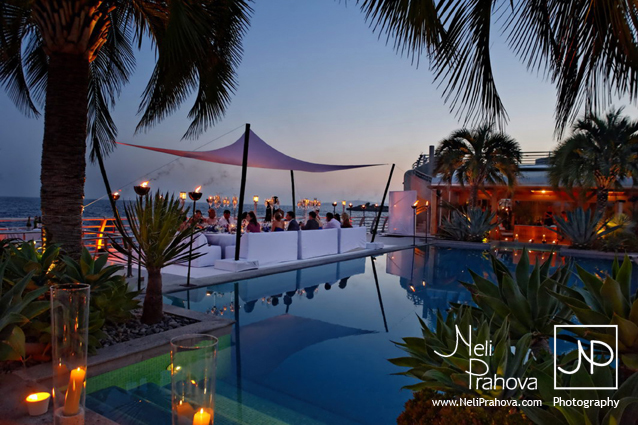
by Michael | Dec 15, 2015 | Blog
Is there any freedom to choose your wedding ceremony?
What if a full religious wedding doesn’t rock your boat?
The non-religious ceremony offered by the Register Office will tick some people’s boxes, but it is standardised. There’s nothing personal or special about it.
What if you could go to the Register Office in the morning in your jeans, with a couple of witnesses, to sign the marriage certificate – and then enjoy a wonderful, joyous ceremony in the afternoon or the next day with all your guests?
Nowadays, that is a possibility.
And your celebrant can really help you.
As long as the legal bit is still carried out, there’s nothing to stop you holding the ceremony you actually want – at the venue you want.
The Ceremony
One of the beauties about a celebrant-led wedding is that you will receive help (as much or as little as you want!) to build your own ceremony. So if you do want a religious component (and you are welcome to draw from various cultural sources), you can put it in; if you want spiritual elements, that’s absolutely possible; choosing your favourite poems and readings is an option that can contribute such a lot. Usually, you’ll be able to please yourselves AND keep your parents happy!
As well as the readings, you decide on the music. You also decide on the choreography (who walks or stands where), readers, the wording, and recital of the Vows. Your celebrant will be pleased to advise and make helpful suggestions. (This process of getting the ‘script’ word-perfect, usually conducted by e-mail, may take a number of e-mails.)
Ritual
You will be able to incorporate any rituals and little touches that would not otherwise have been possible, if you so wish. For example, why not drink together from a loving cup, light a Unity Candle or celebrate a handfasting (an ancient Celtic betrothal ritual)?
Conclusion
In short, this is YOUR day, and your celebrant, who will of course conduct the ceremony for you, will do everything to ensure that the day is unforgettable, meaningful and what YOU want.
Unlike previous generations, you have the freedom to choose every single thing about your ceremony, so that it fits in totally with your personal beliefs and wishes. Why shouldn’t your big day be exactly what you want it to be?
Let your civil celebrant work with you to ensure you achieve that rare goal of turning your dreams into reality.
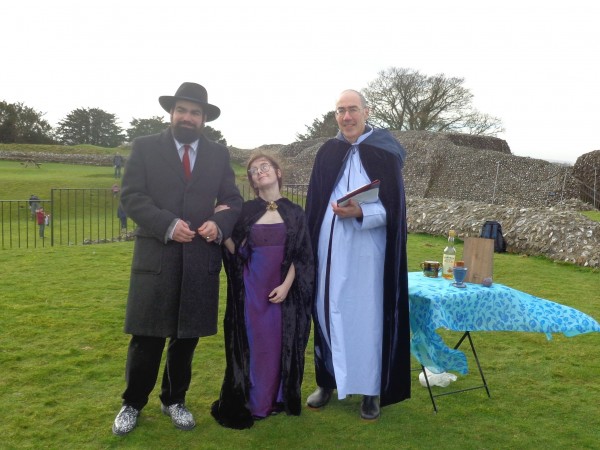
by Michael | Dec 7, 2015 | Blog
The Winter Solstice is almost upon us (depending when you read this!). It’s a fantastic time for a solstice handfasting.
“For what?” I hear some of you say.
Allow me to elaborate.
If you don’t know, I am assuming that you are not a Druid or pagan, and if you are, please understand that I am writing this for the uninitiated. There are, however, different kinds of handfastings, so there’s no single answer to the question.
Example of a handfasting
Remember when Kate and Prince William got married? Although it was a religious C of E ceremony, there was an element of handfasting in there when the couple took each other’s hands, and they were covered by a ribbon.
It was a lovely simple ritual.
Now if you take that one step further and bind the two hands together, you have a handfasting.
Incidentally, this gives rise to the expression “tying the knot” and also “bonds of holy matrimony”.
Origins
This ceremony probably originated in Celtic times; however, it flourished in Europe until the mid 1700s. Up till then, few unions were sanctified in a religious building like a church. Rather, they were celebrated by a simple handfasting ceremony in which the two partners joined hands over the village anvil, in the fields or in the groves of trees. Today, we build upon this tradition.
The basics
The couple link and cross hands (normally right hand to right, and left to left) to form an infinity circle, symbolising the entirety of the universe as represented in their relationship. Then, with a cord or ribbon (or ribbons), the wrists are tied and knotted, in a lovers’ knot, to the accompaniment of a suitable text, to symbolise the joining together of the two people in lives and spirits.
The cords are then removed, normally by the couple – occasionally, with difficulty! – with the knots still in place. They will take the cord away with them and, ideally, it will remind them of their vows, should they hit a rocky patch.
Where does this happen?
Again, it depends, but many people prefer a quiet, open-air historic site that may be considered to be spiritual and preferably pagan – such as standing stones.
What about Stonehenge?
A civil celebrant, such as myself, can conduct a handfasting wedding or vow renewal in the Inner Circle at Stonehenge (normally around dawn or dusk), but this needs to be booked months in advance (and the Druids will have priority at the solstice). However, places like Avebury, Old Sarum or the Rollright Stones might do very well.
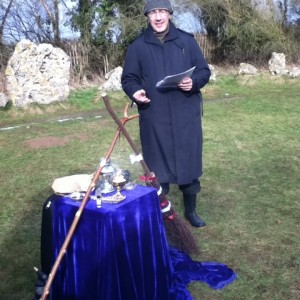
Michael raring to go at the Rollright Stones
It’s a little late for this Winter, but do have a chat (07931 538487) and see if we can sort something very special out for you for another time!

by Michael | Nov 30, 2015 | Blog
People regularly ask me “what’s a handfasting?”
I think my favourite one was at Old Sarum in 2014, and describing the events may give a flavour of the ceremony and thus answer the question.
The Setting
The setting was spectacular. We were allocated a lovely rectangular grassy spot in the Castle ruins, overlooking, as well as a flooded plain, the ruins of the old cathedral.
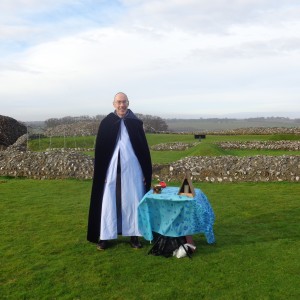
Having an outdoor ceremony the last weekend of January on an exposed hilltop with the winter we’d been having might be said to be tempting providence. I had to drive through heavy rain for a couple of hours the evening before to get to Wiltshire, so I feared the worst. Then my arrival home after the ceremony coincided with thunder, lightning and hailstones! So what about the intervening spell?
The Weather
Miraculously, it was dry – in fact, the sun came out for quite a time – and unseasonably warm. I did eventually get cold, as I was up there early, to set up the space, and the wedding party arrived half an hour late, but to spend two hours, as I did, up there without ill effects from the weather was quite remarkable. I did have a close encounter with a hawk (wondering if it was a vulture, preparing to feast on my frozen body!).

The Ceremony
The ceremony was part-pagan, part-Jewish, which is original, if nothing else! The rituals included representatives of the four elements blessing the couple, the handfasting itself, the bride walking round the groom seven times and the breaking of a glass underfoot.
The handfasting
In a little more detail regarding the actual handfasting, we started by charging the circle. Then we summoned the elements of nature, with representatives of the four directions blessing the couple. We then called upon the God and Goddess, to connect the couple with the divinity within themselves. We next blessed the couple with divine qualities.
Taking symbolic (empty) cups and exchanging them, the couple repeated this Celtic handfasting vow together:
“You cannot possess me, for I belong to myself.
But while we both wish it, I give you that which is mine to give.
You cannot command me, for I am a free person.
I pledge to you that it will be your eyes into which I smile every morning.
I pledge to you my living and my dying, each equally in your care.
I shall be a shield for your back, and you for mine.
I shall not slander you, nor you me.
I shall honour you above all others, and when we quarrel, we shall do so in private and tell no strangers our grievances.
This is my wedding vow to you.
This is the marriage of equals.”
Rather beautiful, wouldn’t you agree?
After the exchange of vows, we witnessed the handfasting(or binding of wrists) itself, followed by drinking from (what was not an empty!) loving cup, before a concluding blessing.
I’m delighted to say that it was a very special ceremony for all concerned – and I’m looking forward to my next one.

by Michael | Oct 22, 2015 | Blog
One of my favourite ceremonies, of all I have conducted, must be the handfasting wedding at Old Sarum iron age fort, overlooking Salisbury.
The weather turned out to be mild and dry –remarkable, considering that there had been serious flooding either side of the ceremony. The sun even came out on the lucky couple.
It was my first handfasting, and, to be honest, something I had never heard of until relatively recently. It turned out to be a moving and memorable occasion for all concerned, all the more interesting as a Pagan was marrying a half-Jew (with elements from both religions being included).
In my experience, few people have even heard of handfastings, so a word or two of explanation might not go amiss here.
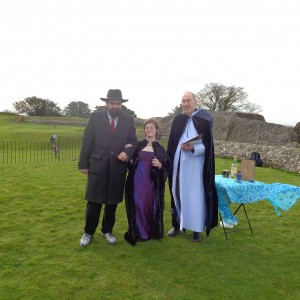
Just what is a handfasting?
A handfasting is a Celtic ceremony, which is a betrothal or wedding ritual in which the couple’s clasped hands are draped with a cord or ribbon while they hold hands. Their hands (or wrists, actually) are literally tied together. In the traditional version, hands are knotted together from 10 a.m. till midnight, which is certainly interesting, if only logistically!
Each partner holds the hands of the other (right hand to right; left to left) with their wrists crossed. The ribbon is wound around the wrists over the top of one and under and around the other, thus creating the infinity symbol.
Hence, “tying the knot” and “bonds of matrimony”!
What is its origin?
This ancient, Celtic, nature-related, spiritual tradition dates back to way before weddings took the form (legally and ritually) that they do today. It is a ceremony of commitment that was first recorded 4,000 years ago.
Who would choose this?
People who do not want a formal, conventional religious ceremony might well enjoy and appreciate this beautiful and meaningful ceremony. Some choose it, as did Anne and Ross, for their wedding; others, after saying their vows; and still others at a betrothal for one year and a day (like a trial period, at the end of which participants can decide whether or not to renew).

Where can this take place?
Subject to permission, this ceremony can be held more or less anywhere, indoors or out. I can perform handfastings in the inner circle at Stonehenge, but there are no shortages of alternative atmospheric venues, such as Old Sarum.
It is a refreshing and lovely ritual and deserves to be better known about.
by Michael | Aug 19, 2015 | Blog
Most people are familiar with the line that we have two ears but only one mouth because we ought to be listening twice as much as we speak.
Well, you might wonder how that applies in my job, as the popular image of a civil celebrant is that person standing up at the front, conducting the ceremony – be it a wedding, funeral, handfasting, blessing, naming or whatever – and jabbering away. In other words, I do the speaking and you (have to) do the listening!
However, there is another part of the proceedings that you probably wouldn’t think about, and that is when the ears/mouth equation comes into its own for me. That is during my planning meeting with the client.
After the initial contact, I almost always visit the next-of-kin, if it’s a funeral, or, if it’s a celebration, arrange a face-to-face or Skype meeting with the couple. As well as being an opportunity to see if we’re both OK to work together, this is a chance for the client to ask questions in an unintimidating atmosphere. For me, it is also an opportunity to ask questions and also to suggest ideas. (Yes, that does involve more talking!)
However, in reality, most of this conversation for me will be spent listening (although there is the occasional case – usually caused by shock after a death – when the client will say next to nothing, and I have to work at gaining their trust). I need to pay close attention, as I often have to pick up clues about what the client wants, as they may not really have much of a conscious idea themselves.
If the client does know exactly what they are looking for, my role is to take note so I can mould it in the best possible, most effective, way. I may question an element or two (“do you realise that …?”), but it’s not my job to change anything (provided everything’s legal, etc.).
I respect their wishes – they can have a mixture of religious elements (or none, if they choose) – and I try to accommodate any preferences they may have for readings, music and participants.
If they don’t know what they want, then I ask questions to get a sense for the sort of thing they may like and provide suggestions for possible rituals to fit the bill. When I finish, I try and put this all together to construct a meaningful and memorable ceremony that meets the needs – and beliefs – of the client. So maybe I do still sometimes talk a bit more than I listen, but I hope I’m getting the balance right.
Another way I’d love to put “two ears, one mouth” into practice is to respond to any requests you may have for subjects for me to deal with in my blogs. To quote my hero, Frasier Crane, “I’m listening!”






